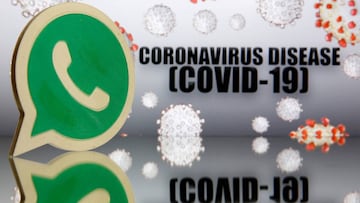What is the name of the coronavirus: Covid-19, SARS-CoV-2...
The official scientific name of the coronavirus causing the current pandemic is SARS-CoV-2, but the disease itself is known as Covid-19.


The coronavirus pandemic currently affecting 204 countries and territories around the world, and which has caused nearly a million cases and over 50,000 deaths, is commonly referred to as simply ‘coronavirus’, but what is its official name?
The official name for the disease caused by the new coronavirus is Covid-19, while the scientific name for the virus that causes the disease is SARS-CoV-2.
How did the new coronavirus get its name?
The current pandemic is caused by a new strain from the coronavirus family, which infect birds and mammals. Prior to this new virus we knew of six coronaviruses that affect humans, all of which cause respiratory tract infections: four which cause common colds, and two which cause MERS, Middle Eastern Respiratory Syndrome and SARS, Severe Acute Respiratory Syndrome, respectively.
Strictly then the term ‘coronavirus’ could be referring to any of the entire family of coronaviruses, although right now it’s being used in most mainstream media to refer simply to the current pandemic.
On 11 February the World Health Organisation (WHO) announced that the name for the disease would be COVID-19, with CO referring to corona, VI to Virus, D to disease and 19 to 2019, when the first case was identified, near the end of the year in Wuhan, China.
Where WHO refer to the virus itself they call it the Covid-19 virus. Prior to announcing the new name WHO had been calling it 2019 novel coronavirus or 2019-nCoV (you might still see that on older texts, as WHO have said they will not update already published material unless it is confusing).
SARS-CoV-2: The scientific name for the virus
'Covid-19 virus' is not, however, the scientific name for the virus. The International Committee on Taxonomy of Viruses the body who decide what viruses are called have named it Severe Acute Respiratory Syndrome Coronavirus 2”, or SARS-CoV-2. Their reason for the name is because the virus is genetically related to the one that caused the SARS outbreak in 2003.
However WHO have said they will not use the term SARS (or SARS-CoV-2) when communicating with the public because it could have “unintended consequences in terms of creating unnecessary fear for some populations, especially in Asia which was worst affected by the SARS outbreak in 2003.”
WHO will therefore refer to the virus as “the virus responsible for COVID-19” or “the COVID-19 virus” although they note that neither is intended as a replacement for the official name: SARS-CoV-2.
WHO also make it clear why viruses and the diseases they cause often have different names, pointing out that measles, the disease, is caused by a virus, rubeola, the name of which would likely be unknown to many people.
Not Chinese Coronavirus
It is important to note that all terms such as Chinese Flu, Chinese Coronavirus, Wuhan Virus or similar are incorrect, and may well be being used in a racist, inflammatory or prejudicial manner.
The guidelines on naming diseases prevent references to geographical locations, animals, individuals or groups of people. Avoiding any stigma related to disease is important and can lead to people with symptoms not coming forward, or hostility towards certain groups.
Chinese communities around the world have suffered abuse and physical attacks during the current pandemic.
Of note here is that MERS, Middle Eastern Respiratory Syndrome, does refer to a place, however when deciding on the name officials from the countries particularly affected by the disease were happy to use the term Middle Eastern as they felt it is sufficiently large an area to avoid stigmatising any one group.
COVID-19, Covid-19 or covid-19
A final note, on the style of writing 'Covid-19'. Here at AS English we started out using COVID-19, as it is styled by WHO, however we fairly rapidly decided to drop the all-caps style as we tend not to capitalise where we can help it, and although COVID is an acronym (being made up of groups of letters from the words that make up the full name), it has the feeling of having morphed into its own word at this point. The Guardian, for example, has also gone down this route. Both the Economist and New Scientist have gone further and moved to all lower case, simply covid-19,which might possibly be more consistent with our own style guide; measles, whooping cough and influenza don’t get a capital letter, so why should Covid-19? Right now we haven’t changed, but it’s likely we will, particularly as and when the pandemic is over and normal life has returned, with Covid-19 being a disease we have successfully controlled through vaccination.
Related stories
On a style guide note, we very much enjoyed this cartoon by @IvaCheung
Editing in the time of COVID-19 (covid-19? CoViD-19?): https://t.co/aqmHUWjPaU by @IvaCheung pic.twitter.com/yIBo0MPGTw
— Jonathon Owen (@ArrantPedantry) April 1, 2020

